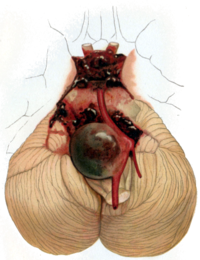
Photo from wikipedia
This was a retrospective review of 1340 patients with 1595 unruptured saccular intracranial aneurysms that underwent endovascular coil embolization between February 2010 and December 2014. The clinical outcomes of patients… Click to show full abstract
This was a retrospective review of 1340 patients with 1595 unruptured saccular intracranial aneurysms that underwent endovascular coil embolization between February 2010 and December 2014. The clinical outcomes of patients with procedural rupture of saccular intracranial aneurysms were compared with those of 198 patients presenting with spontaneously ruptured aneurysms. Procedural rupture developed in 19 patients, and the morbidity related to procedural rupture was 26.3% with no mortality. Hunt and Hess scale grades and hospitalization days of patients with procedural rupture were equivalent to those of patients presenting with spontaneous aneurysm rupture. In multivariate analysis, spontaneous aneurysm rupture was a significant risk factor for worse clinical outcome. This study showed better clinical outcomes in the procedural-rupture group. BACKGROUND AND PURPOSE: Procedural rupture of an intracranial aneurysm is a devastating complication in endovascular treatment. The purpose of this study was to evaluate the clinical outcomes of patients with procedural rupture of unruptured saccular intracranial aneurysms compared with those with spontaneously ruptured aneurysms. MATERIALS AND METHODS: A retrospective review was performed for 1340 patients with 1595 unruptured saccular intracranial aneurysms that underwent endovascular coil embolization between February 2010 and December 2014. The clinical outcomes of patients with procedural rupture of unruptured saccular intracranial aneurysms were compared with those of 198 patients presenting with spontaneously ruptured aneurysms. RESULTS: In this series, procedural rupture developed in 19 patients (1.4% per patient and 1.2% per aneurysm), and the morbidity related to procedural rupture was 26.3% (95% confidence interval, 8.5%–61.4%) with no mortality. Hunt and Hess scale grades and hospitalization days of patients with procedural rupture were equivalent to those of patients presenting with spontaneous aneurysm rupture. Subsequent treatment procedures after hemorrhage (including lumbar drainage, extraventricular drainage, decompressive craniectomy, and permanent shunt) showed no difference between the 2 groups. The hemorrhage volumes were smaller in the procedural-rupture group (P = .03), and the endovascular vasospasm therapies tended to be more frequently required in the spontaneous aneurysm–rupture group (P = .08). At postictus 6 months, the proportion of modified Rankin Scale scores of ≥2 were lower in the procedural-rupture group (5.3% versus 26.8%, P = .049). In multivariate analysis, spontaneous aneurysm rupture was a significant risk factor for worse clinical outcome (OR = 14.9; 95% CI, 1.2–193.1; P = .039). CONCLUSIONS: This study showed better clinical outcomes in the procedural-rupture group. Even though there is a potential chance of aneurysm rupture during treatment, the clinical outcomes after procedural bleeds seem to be more favorable than those of spontaneous rupture.
Journal Title: American Journal of Neuroradiology
Year Published: 2017
Link to full text (if available)
Share on Social Media: Sign Up to like & get
recommendations!